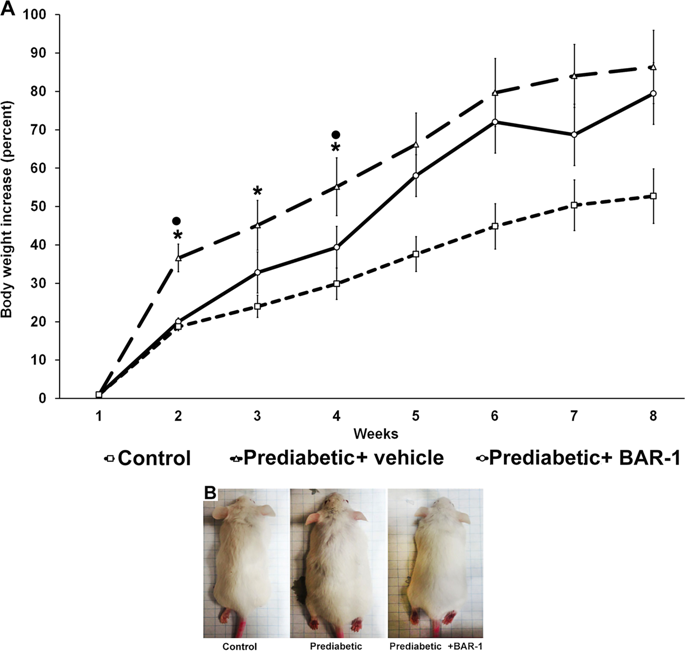当前位置:
X-MOL 学术
›
Nutr. Diabetes
›
论文详情
Our official English website, www.x-mol.net, welcomes your feedback! (Note: you will need to create a separate account there.)
Novel CB1 receptor antagonist BAR-1 modifies pancreatic islet function and clinical parameters in prediabetic and diabetic mice.
Nutrition & Diabetes ( IF 6.1 ) Pub Date : 2020-03-04 , DOI: 10.1038/s41387-020-0110-0 Lesly Nava-Molina 1 , Toyokazu Uchida-Fuentes 1 , Héctor Ramos-Tovar 1 , Martha Fregoso-Padilla 1 , Marco Aurelio Rodríguez-Monroy 1 , Ana V Vega 1 , Gabriel Navarrete-Vázquez 2 , Erik Andrade-Jorge 1 , Rafael Villalobos-Molina 1 , Ricardo Ortiz-Ortega 1 , Alonso Vilches-Flores 1
Nutrition & Diabetes ( IF 6.1 ) Pub Date : 2020-03-04 , DOI: 10.1038/s41387-020-0110-0 Lesly Nava-Molina 1 , Toyokazu Uchida-Fuentes 1 , Héctor Ramos-Tovar 1 , Martha Fregoso-Padilla 1 , Marco Aurelio Rodríguez-Monroy 1 , Ana V Vega 1 , Gabriel Navarrete-Vázquez 2 , Erik Andrade-Jorge 1 , Rafael Villalobos-Molina 1 , Ricardo Ortiz-Ortega 1 , Alonso Vilches-Flores 1
Affiliation

|
BACKGROUDS
Cannabinoid receptor antagonists have been suggested as a novel treatment for obesity and diabetes. We have developed a synthetic cannabinoid receptor antagonist denominated BAR-1. As the function and integrity of a β-cell cellular structure are important keys for diabetes onset, we evaluated the effects of pharmacological administration of BAR-1 on prediabetic and diabetic rodents.
METHODS
CD-1 mice fed a hypercaloric diet or treated with streptozotocin were treated with 10 mg/kg BAR-1 for 2, 4 or 8 weeks. Body weight, oral glucose tolerance test, HbA1c, triglycerides and insulin in serum were measured. In isolated islets, we evaluated stimulated secretion and mRNA expression, and relative area of islets in fixed pancreases. Docking analysis of BAR-1 was complemented.
RESULTS
BAR-1 treatment slowed down weight gain in prediabetic mice. Fasting glucose-insulin relation also decreased in BAR-1-treated mice and glucose-stimulated insulin secretion was increased in isolated islets, without effects in oral test. Diabetic mice treated with BAR-1 showed a reduced glucose and a partial recovery of islet integrity. Gene expression of insulin and glucagon showed biphasic behaviour, increasing after 4 weeks of BAR-1 administration; however, after 8 weeks, mRNA abundance decreased significantly. Administration of BAR-1 also prevents changes in endocannabinoid element expression observed in prediabetic mice. No changes were detected in other parameters studied, including the histological structure. A preliminary in-silico study suggests a close interaction with CB1 receptor.
CONCLUSIONS
BAR-1 induces improvement of islet function, isolated from both prediabetic and diabetic mice. Effects of BAR-1 suggest a possible interaction with other cannabinoid receptors.
中文翻译:

新型 CB1 受体拮抗剂 BAR-1 可改变糖尿病前期和糖尿病小鼠的胰岛功能和临床参数。
背景大麻素受体拮抗剂已被建议作为肥胖和糖尿病的新治疗方法。我们开发了一种合成大麻素受体拮抗剂,命名为 BAR-1。由于 β 细胞细胞结构的功能和完整性是糖尿病发病的重要关键,因此我们评估了 BAR-1 对糖尿病前期和糖尿病啮齿动物的药理学作用。方法 用高热量饮食喂养或用链脲佐菌素治疗的 CD-1 小鼠用 10 mg/kg BAR-1 治疗 2、4 或 8 周。测量体重、口服葡萄糖耐量试验、HbA1c、血清甘油三酯和胰岛素。在分离的胰岛中,我们评估了刺激的分泌和 mRNA 表达,以及固定胰腺中胰岛的相对面积。补充了 BAR-1 的对接分析。结果 BAR-1 治疗减缓了糖尿病前期小鼠的体重增加。BAR-1治疗小鼠的空腹血糖-胰岛素关系也降低,孤立胰岛中葡萄糖刺激的胰岛素分泌增加,但在口服试验中没有影响。用 BAR-1 治疗的糖尿病小鼠表现出血糖降低和胰岛完整性部分恢复。胰岛素和胰高血糖素的基因表达呈现双相行为,在施用 BAR-1 4 周后增加;然而,8周后,mRNA丰度显着下降。BAR-1 的施用还可以防止在糖尿病前期小鼠中观察到的内源性大麻素元件表达的变化。没有检测到其他研究参数的变化,包括组织学结构。初步的计算机模拟研究表明与 CB1 受体有密切的相互作用。结论 从糖尿病前期和糖尿病小鼠中分离得到的 BAR-1 可以诱导胰岛功能的改善。BAR-1 的作用表明可能与其他大麻素受体相互作用。
更新日期:2020-03-04
中文翻译:

新型 CB1 受体拮抗剂 BAR-1 可改变糖尿病前期和糖尿病小鼠的胰岛功能和临床参数。
背景大麻素受体拮抗剂已被建议作为肥胖和糖尿病的新治疗方法。我们开发了一种合成大麻素受体拮抗剂,命名为 BAR-1。由于 β 细胞细胞结构的功能和完整性是糖尿病发病的重要关键,因此我们评估了 BAR-1 对糖尿病前期和糖尿病啮齿动物的药理学作用。方法 用高热量饮食喂养或用链脲佐菌素治疗的 CD-1 小鼠用 10 mg/kg BAR-1 治疗 2、4 或 8 周。测量体重、口服葡萄糖耐量试验、HbA1c、血清甘油三酯和胰岛素。在分离的胰岛中,我们评估了刺激的分泌和 mRNA 表达,以及固定胰腺中胰岛的相对面积。补充了 BAR-1 的对接分析。结果 BAR-1 治疗减缓了糖尿病前期小鼠的体重增加。BAR-1治疗小鼠的空腹血糖-胰岛素关系也降低,孤立胰岛中葡萄糖刺激的胰岛素分泌增加,但在口服试验中没有影响。用 BAR-1 治疗的糖尿病小鼠表现出血糖降低和胰岛完整性部分恢复。胰岛素和胰高血糖素的基因表达呈现双相行为,在施用 BAR-1 4 周后增加;然而,8周后,mRNA丰度显着下降。BAR-1 的施用还可以防止在糖尿病前期小鼠中观察到的内源性大麻素元件表达的变化。没有检测到其他研究参数的变化,包括组织学结构。初步的计算机模拟研究表明与 CB1 受体有密切的相互作用。结论 从糖尿病前期和糖尿病小鼠中分离得到的 BAR-1 可以诱导胰岛功能的改善。BAR-1 的作用表明可能与其他大麻素受体相互作用。



























 京公网安备 11010802027423号
京公网安备 11010802027423号